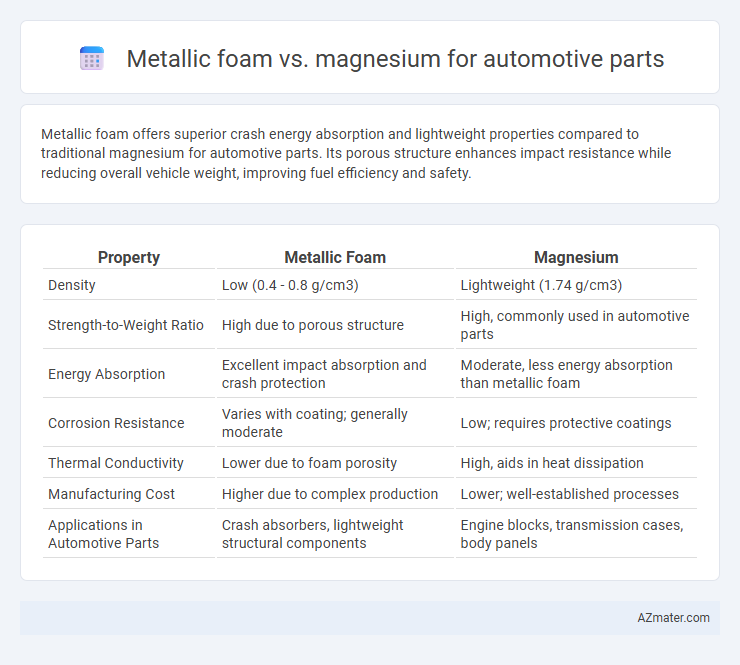Metallic foam offers superior crash energy absorption and lightweight properties compared to traditional magnesium for automotive parts. Its porous structure enhances impact resistance while reducing overall vehicle weight, improving fuel efficiency and safety.
Table of Comparison
| Property | Metallic Foam | Magnesium |
|---|---|---|
| Density | Low (0.4 - 0.8 g/cm3) | Lightweight (1.74 g/cm3) |
| Strength-to-Weight Ratio | High due to porous structure | High, commonly used in automotive parts |
| Energy Absorption | Excellent impact absorption and crash protection | Moderate, less energy absorption than metallic foam |
| Corrosion Resistance | Varies with coating; generally moderate | Low; requires protective coatings |
| Thermal Conductivity | Lower due to foam porosity | High, aids in heat dissipation |
| Manufacturing Cost | Higher due to complex production | Lower; well-established processes |
| Applications in Automotive Parts | Crash absorbers, lightweight structural components | Engine blocks, transmission cases, body panels |
Introduction to Advanced Automotive Materials
Metallic foam offers lightweight strength and enhanced energy absorption, making it ideal for impact-resistant automotive components. Magnesium, known for its high strength-to-weight ratio and excellent machinability, provides superior performance in lightweight structural parts. Combining metallic foam with magnesium alloys advances automotive materials by improving fuel efficiency and crashworthiness.
Overview of Metallic Foams
Metallic foams, characterized by their porous structure, provide an outstanding strength-to-weight ratio, making them ideal for automotive parts where weight reduction is crucial. Compared to magnesium, metallic foams offer superior energy absorption and improved crashworthiness due to their unique cellular architecture. These properties enhance vehicle safety and fuel efficiency, positioning metallic foams as a cutting-edge material for automotive applications.
Properties of Magnesium in Automotive Applications
Magnesium's lightweight nature and high strength-to-weight ratio improve fuel efficiency and vehicle performance in automotive parts. Its excellent vibration damping and thermal conductivity enhance structural integrity and heat dissipation in engine components. Corrosion resistance and ease of machinability further support magnesium's widespread use in automotive applications.
Weight Reduction: Metallic Foam vs Magnesium
Metallic foam offers significant weight reduction in automotive parts due to its porous structure, providing a density much lower than solid magnesium while maintaining adequate strength. Magnesium alloys are lightweight with a density around 1.74 g/cm3, but metallic foam can achieve densities as low as 0.5 g/cm3, making it a superior option for reducing overall vehicle mass. This drastic weight difference contributes to improved fuel efficiency and enhanced performance in automotive applications.
Mechanical Strength and Durability Comparison
Metallic foam exhibits superior energy absorption and impact resistance compared to magnesium, making it ideal for automotive parts requiring enhanced crashworthiness and lightweight characteristics. Magnesium alloys offer higher tensile strength and stiffness but are more prone to corrosion and fatigue, affecting long-term durability in harsh environments. The combination of metallic foam's lightweight structure with magnesium's mechanical properties can optimize strength-to-weight ratios and improve overall component lifespan in automotive applications.
Crashworthiness and Safety Performance
Metallic foam exhibits superior energy absorption and impact damping compared to traditional magnesium alloys, enhancing crashworthiness in automotive applications. The open-cell structure of metallic foam effectively dissipates crash energy, reducing occupant injuries and improving safety performance metrics. Magnesium offers lightweight benefits but lacks the same level of deformation control and energy absorption capacity as metallic foam in high-impact scenarios.
Thermal Conductivity and Heat Management
Metallic foam demonstrates superior thermal conductivity compared to magnesium, enabling enhanced heat dissipation in automotive parts and improving overall thermal management. Magnesium, while lightweight and corrosion-resistant, has lower thermal conductivity, which limits its efficiency in rapidly transferring heat away from critical components. Utilizing metallic foam in automotive applications optimizes heat distribution, reduces hotspots, and helps maintain engine performance and safety under high thermal stress.
Corrosion Resistance and Longevity
Metallic foams, especially aluminum and titanium variants, offer enhanced corrosion resistance in automotive parts compared to magnesium due to their stable oxide layers that prevent degradation in harsh environments. Magnesium, while lightweight and strong, is prone to rapid corrosion without specialized coatings or treatments, reducing its longevity in automotive applications. Therefore, metallic foams provide superior durability and extended service life in automotive components exposed to moisture and corrosive elements.
Cost and Manufacturing Considerations
Metallic foam offers significant weight reduction and enhanced energy absorption for automotive parts but generally incurs higher manufacturing costs due to complex casting and specialized processing techniques compared to magnesium. Magnesium, while less expensive and easier to machine with conventional methods, presents challenges such as lower corrosion resistance and potential issues in high-stress applications. Cost-effectiveness depends on balancing the advanced performance characteristics of metallic foam against magnesium's affordability and established production infrastructure.
Future Trends and Industry Adoption
Metallic foam is gaining traction in the automotive industry due to its lightweight structure, excellent energy absorption, and thermal management capabilities, making it ideal for crash safety components and heat exchangers. Magnesium remains popular for its exceptional strength-to-weight ratio, corrosion resistance, and recyclability, driving its use in structural and body parts to improve fuel efficiency and reduce emissions. Future trends indicate increased hybrid applications combining metallic foam and magnesium to leverage their complementary properties, supported by advancements in manufacturing processes like additive manufacturing and expanded industry adoption for electric vehicle components.

Infographic: Metallic foam vs Magnesium for Automotive part
 azmater.com
azmater.com